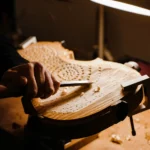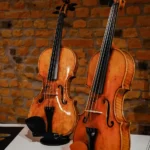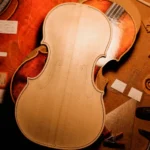Top 5 Facts About Stradivari: The history of the Stradivari Violin
Back to BlogFacts about Antonio Stradivari’s History
Known all over the world, Stradivari crafted an estimated 1,000 instruments, 650 of which survive today. Born in 1644 and originally from Cremona, Antonio Stradivari is known as one of the best violin-makers! The luthier spent 71 years crafting violins, violas, and cellos, which is quite a lot for somebody who lived in the 17th and 18th centuries.
Scroll down to find out more about this great maker of the past!
1. Unlike many luthiers from the time, Stradivari wasn’t born into a family of violin makers.
But as a son of notable citizens of Cremona, he began his first violin-making apprenticeship at a young age, supposedly under the influence of Nicola Amati. He built his reputation as a fine maker by selling instruments to royal families and notable citizens.
His life can be divided into 4 periods:
- The Amatisé: 1660 – 1690
- The Long Pattern: 1690 – 1700
- The Golden Period: 1700 – 1720
- The Late Period: 1720 – 1737
Each of these periods has its distinctive characteristics, but The Golden Period was, no doubt, the time in which Stradivari made his finest work.
2. Stradivari made some key changes to his design:
The Long Pattern period was characterized by a larger violin, known as a “Long Strad”. Branching out from the standard sizing, Strad’s violins from this time were 12mm longer than the traditional model. It is also worth noting that he might have taken his inspiration from Brescian makers, such as Maggini and Gaspar da Salò, who were known for crafting instruments with a darker, more powerful sound.
From this point on, Stradivari’s lutherie visibly improves, as does his choice of wood. He incorporates an intense red, golden varnish into his instruments. Another important fact was the change in the arching of the top plate, meaning the instrument was less flexible, adding more resistance to the plate so the musician could play deeper sounds with this stronger core.
An essential step in his making career, this period guided him toward his infamous Golden Period. It is believed that these refinements were the key behind the exceptional sound projection and resonance of his instruments, especially in the 17th century, when musical performances were just starting to happen inside concert halls.
3. The hit of his career
From 1700 – 1725, Stradivari hit the peak of his violin-making career. It was at this time that he distanced himself from the long pattern violin and returned to the standard, smaller-sized instrument.
Although not technically beginning until 1700, some of Stradivari’s earlier work from the 1690s mirrored the quality of those crafted in his golden years. Somewhat controversially, many of these instruments actually had their original labels amended to dates post-1700 so that they could be sold at an increased value; any instrument crafted during this time was and remains to be held in high esteem, worth millions and ever-increasing in worth.
His financial gain is also notable at this time. Stradivari’s instruments were more sophisticated. The quality of materials used during the golden period speaks for that. He was evidently much more financially stable, enabling him to invest in the finest products to craft with. Some say his rich varnish was one of his biggest kept secrets!
The early golden years saw Stradivari introduce long, elegant corners to his work, ones that were slightly rounder and more curved than previous instruments. By 1704, he changed the proportions of the purfling, too, increasing the width of the inner white section.
In 1708, the arching became much fuller in comparison to previous instruments, although it was still flatter than other violins of the time. This arching benefited the sound greatly, allowing it to resonate more powerfully. The years prior to 1709 were transformative years for Stradivari, leading him toward the peak of his career. By 1710, he was confident in his approach, allowing him to settle in and focus on the making itself, turning his golden period into the most productive one.
4. The mystery of a genius maker
Stradivari instruments are known for a perceived sound quality superior to stringed instruments made by other violin makers. Around 2003, scientists studied his work and concluded there was a reduction in solar activity during the 17th century, causing slower tree growth that led to a denser wood, which appears to be the reason for the Stradivarius sound.
And others say at that time, Stradivari and others added a mysterious ingredient to the wood or used techniques that have since been lost.
5. What makes a Strad a Strad
Every instrument is unique because of its maker’s skills and abilities. In this case, there are a few characteristics that compose a genuine Stradivari model.
The f-holes are very important to create sound. Stradivari made some f-holes longer and narrower; his work was somewhat longer in a few periods, with sharper-edged corners and a clear definition between its upper and lower half.
The varnishing and wood. He used alpine wood, such as spruce and maple wood. Some researchers have found traces of minerals like copper and aluminum in the varnish. Stradivari is known for his superior craftsmanship, making instruments that produce superior tonal qualities compared to other violins. The violins by Stradivari are also known for their perfection, with every bit of detail precisely done.
Nowadays, makers still get inspiration from Stradivari’s work by creating their instruments based on the models of this great master. We have some examples of Stradivari’s models at Amorim Fine Violins Cremona, scroll down and have a look at them!
VIOLIN BY LUIZ AMORIM, CREMONA, 2022
STRADIVARI MODEL
This violin is a precise copy crafted by a master maker. An accurately handcrafted violin, replicating every single detail of the original one. Follows the Italian traditional handcraftsmanship featuring Luiz’s passions of liberty and expressiveness in a work of art. From our perspective, the main feature of this instrument is the beautiful visual impact of the one-piece back.
VIOLIN BY ANDREA GIOVANNETTI, FLORENCE, 2022
STRADIVARI MODEL
The hands of a rising star-maker crafted this antiqued Stradivari model. Andrea faithfully represents the new generation of Italian violin makers, bringing modern thinking to the violin-making scenario. For us, its high point is the violin’s scroll; it is a delicate and well-crafted one.
VIOLIN BY MARTIN STOYANOV, CREMONA, 2020
STRADIVARI MODEL
This violin, a Stradivari model, was crafted by the hands of an experienced maker. It is a great example of Cremonese traditional handcraftsmanship. In our judgment, the high spot of this violin is the delicate deep fluting around the f-holes wings and lower eyes.
VIOLIN BY ANNA ARIETTI, CREMONA, 2021
STRADIVARI MODEL
The hands of a rising-star maker crafted this new-looking Stradivari model. A beautiful Cremona violin that illustrates Anna’s excellent artistry and precise hand skill. For us, its high point is the Strad alike purfling bee-sting, beautifully framing the sharply squared corners.









